ABERFAN
The Days After
Part One
(November 1966)
It was on all the news stations that October morning. First reports: A mountain had fallen on an elementary school in Aberfan, Wales. Hundreds of children were dead or missing along with some of their teachers. It was Friday, 21 October 1966. The children had gone off to school, many of them alone—for Aberfan was a safe town and a small child could walk from one end of the village to the other without fear of being swept away by some lurking criminal. Some waved goodbye to their mothers, others held their father’s hands and kissed their smooth, fresh shaven faces before running up the street, book bags in hand. Others popped out of their parents’ cars on Moy Road, kissed their parents on the mouth, then hurried on to join their little friends at the Pantglas Junior School.
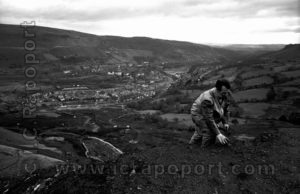
Later, it was determined that an underground spring had been covered by coal Tip #7, a mountain of black slag—the useless tailings dug out of the coal tunnels, years and years ago. At the time the tip was ‘mounted,’ the spring was just a dribble of water and of no concern to anyone, however, after years of Welsh rainy seasons, the water table on the hillside had risen and unbeknownst to those working on the tips, in 1966, the spring was now flowing quite freely. However, it had very little space to find its way down the hill and so the waters spread hither and yon, setting up a slippery film that the massive mountain of dirt and rock sat upon.
Sometime after nine a.m., that Friday morning the south face of the giant coal “tip,” now soaked from continuous autumn rains, began to move. The downhill side of the tip broke free and formed an avalanche of slurry that gathered speed, encouraging more and more slag to break way from its unnatural banks, and in just seconds hundreds of tons of rock and wet dirt rolled down the hillside, plummeted towards the village edge. Unfortunately for the hundreds of families who lived in Aberfan the Pantgast Junior School was the first building in the tumbling avalanche’s path. In a moment the walls of the schoolhouse were destroyed and the muck, water and slurry, filled classroom after classroom, trapping the little children who tried desperately to flee the chaos.
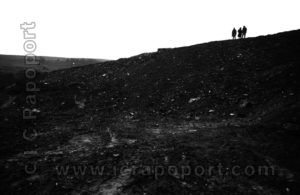
One hundred and sixteen of them were killed that day along with twenty-eight adults. Rescuers were on the scene in minutes. A county road repair crew was a few blocks away and they had heard the awful warning and saw the cascading landslide, saw it smashing into and over and around the schoolhouse and the private homes nearby. Grabbing tools, they ran to the school and in the first few minutes managed to rescue several of the students. The awful cries from beneath the hellish debris anguished the workers as they dug furiously, some with bare hands. More help arrived. People raced up from the Mackintosh Pub, others, on night shifts and still sleepy-eyed, sprang from their beds and were sloshing in the muck in slippers. Police and firemen, other laborers, store clerks, mothers and brothers, schoolmates from the nearby upper school hurried to help.
—————————————————————————
Thousands of miles away I was putting my six month old son to bed after waiting for my wife, Mary, to breast feed him. She fell back to sleep as I covered his small body in his crib in the front room of our apartment on West 72nd Street in Manhattan. I went back our bedroom and slipped in under the covers and stared at the ceiling, at the lighted squares formed by lights from nearby apartments. I was unaware of the tragedy that had crushed a small mining village in South Wales and fell asleep wondering what my next photo assignment would be.
The morning news told me what I had to do. Staring at the newsreel footage of hundreds of men and women ripping at the dirt buried school searching for surviving children sent chills up my spine – as it would to millions of people around the world. The TV announcer said something that resonated with me. He used a phrase something like “what does a town do now? Where does it go from here? Without its children?”
By 10 a.m. I was sitting in the outer office of LIFE magazine’s Managing Editor, Ralph Graves. He was my only hope of sending me to Wales. It was such a long shot but I had to make a stab at it. The years working for Paris Match had taught me many things but the most important being push yourself forward. Go for broke. Go big. I had completed a successful photo essay, The Detective working with fine, Life writer, James Mills. Ralph Graves was impressed with my work and now knew me by name when passing in the corridors.
Graves’ secretary watched me as I sat for what seemed like hours waiting for a chance to talk to him. She began to feel sorry for me and asked if anything was wrong. I told her I just wanted five minutes with Ralph. Finally she told me to go in. Ralph sat in his Life journalist uniform, jacket off, sleeves rolled up an tie loosened and was scanning some cables from far away places.
“What can I do for you, Chuck?” he asked without looking up.
“Aberfan,” was all I began with. But before I could continue he dropped the cablegrams on his cluttered desk.
“We’re doing it. Six pages in this weeks issue, with a possible cover.” He looked at me in a sort of sad way that suggested he wondered if I really thought there was a chance I could be involved in that news story, from five thousand miles away.
“I’m not talking about now,” I answered. “I want to go over next week and shoot an essay on a town without children.”
Ralph stopped and looked off. I imagined he was seeing that essay in the magazine. A Town Without Children. Then he looked at me, as if he was wondering if I was up to it. I couldn’t let him wonder too long about that.
“I can do it, Ralph. I feel this in my bones. I have a six month old boy at home.” And I stared into his eyes.
Ralph leaned back in his chair, way back, with his hands clasped behind his head he shouted out to his secretary. “Get Hal Wingo in here, please.” Hal was the editor in charge of the Humanities Department. Where a story like the one I was proposing would be cared for, nurtured. We waited. Hal Wingo’s very tall Texas frame stepped into the doorway.
“Hal, you know Chuck, don’t you?” Hal nodded, of course he did. I had done several small stories under his control. “Chuck wants to go to Aberfan, that town in Wales where all the kids were killed this morning. He want to do a story, an essay, a town without children.”
Hal expression changed, sort of lit up. “That works for me,” was all he said. “Good luck, Chuck.” And he nodded and went back to work. I sat turning back to Ralph.
Ralph shrugged once and then smiled to me. “What are you waiting for? Go.”
——————————————————-
When I arrived in London, a week after the tragedy, I met with Jim Hicks, the Life London bureau chief. We decided to train out to Cardiff and rent a car for the drive to Aberfan, but we wouldn’t leave for a few days. It was October 30 when we finally did drive into the village and encountered road blocks and earth moving trucks, still clearing up the roadways near the disaster site. We went into the Mackintosh Pub and Hotel which really wasn’t a hotel but Stanley and Pearl, the proprietors, rented us a top floor garret room with windows that faced onto Moy Road and the disaster site.
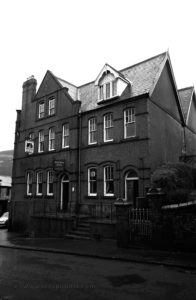
The crisis whistle blew at the coal mine. Citizens, oblivious to the disaster taking place at the schoolhouse, thought there had been a mine disaster and ran to the wrong location. Miners in pit 7 were brought up to the surface, a one-mile ride on the elevators. Armed with their tools, they raced to the school. Hundreds of men and women were tearing to get to the half buried classrooms but for many of the children it was already too late.

“I heard the horns, you know, the whistles were blowing’,” a miner told me as he recalled the morning of the disaster. “We waited for the explosion. That’s what you’re conditioned to do, you know. Somewhere, we figured, the mine was ablaze, gases were leaking, timber was coming’ down. But then on the phones they were yelling’ something about the Panglas School. There was big trouble there and we crowded to get onto the lift. It can hold maybe forty of us and there was hundreds wanting to go up. The waiting’ was terrible, waiting’ for the lift to get up and come back down to take another forty men and all the while we’re all thinking’–-no we were all hoping’–-it was something the fire brigade could take care of, you know. But, it was our kiddies they were talkin’ about. Something’ was happening to our kids and we just had to go.”
Jim left to go back to London after three days of interviews and seeking out contacts for me. I remained, alone, having breakfast with Pearl and Stanley Crowe and their toddler, Justin. I do remember how bloody cold it was, especially in December. The Mackintosh did not have central heating. One amusing moment. Jim Hicks and I went up to Merthyr Tydfil, the larger town not far from Aberfan, and purchased three electric heaters for our attic room. When we plugged them into the wall we blew out the master fuse and the whole Mack went dark. The groans and shouts from the downstairs pub. I had to make do with just two of the heaters. And eventually, just one.

I finally made their acquaintance – townsfolk, all of them. And because their grief and pain were insurmountable they naturally wanted to talk. Between tears and sobs, they talked. Over pints of beer and ale, they talked. To each other and to themselves, they talked. So why not talk to me?
I came down from my third floor room in the Mackintosh Pub that first Saturday night in Aberfan. The pub had filled. Fifty, eighty, men sat in huddled clusters sipping pints of beer and cider. I carried just one Leica with me, with the 28mm f2.8 lens. There was enough light for me to snap images.

If I hand-held the camera steady, shoulder strap wrapped around my arm, I could cock my elbow back, bring the strap taut pressing the camera against my cheek, I could shoot 1/8th of a second. I began shooting pictures as the publican, Stanley, hovered nearby, washing the dozen glasses as he spoke.
“Be very wary,” he said. “Some of them don’t like to see cameras snapping.”
The full impact of my presence in Aberfan hadn’t hit me yet but it sure hit some of the residents. Reporters had left a bad taste in their mouths having descended on the village at the time of the tragedy and as hard as the rescuers clawed and stomped over the site of the disaster, the journalists clawed and stomped over the rescuers’ emotions. Hours after the first reports of the tragedy crisscrossed the airwaves, hundreds of journalists and curious people hurried to Aberfan many as compelled to be in Aberfan as I was. When the first images of the tragic disaster flashed on our television screen I wanted to will myself across the Atlantic, to Wales, to this distant valley, to the narrow streets and row houses, to the mayhem, to the record the rescue attempts, to witness and photograph the anguish and anxiety. I wasn’t the only journalist who had those thoughts, those feelings that “need.” And they descended on Aberfan in hordes; camera crews, still photographers, reporters. Hundreds fell upon the village. “Like a barbarian horde, they were, Chuck,” Stanley told me. “Like wild animals pillaging our souls,” an old man said, his lips inches from his beer.
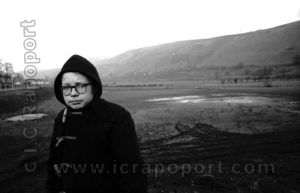
The villagers were caught unawares. Their immediate task was to rescue which was followed by their grief and then their mourning. They had no time for interviews, no time for posing for pictures. Whenever they looked up from their gruesome toiling there was a stranger with a camera or a microphone aimed at them. The press corps was as relentless for a scoop as were the families tearing at the dirt with bloodied bare hands. All the members of the press were not callous. Many broke down in tears.
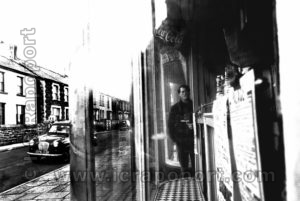
For weeks I wandered the streets of Aberfan, one or two cameras in hand with 5 or 6 rolls of Tri-X film. My idea was to not look like a Christmas tree of cameras – glass and straps. It was enough that I was there, picking over their grief, why make it look like I had a rich uncle who supplied with me the latest cameras – which by the way, were the latest. Three Leica M2 cameras with three different lenses: A 28mm wide angle which became my go-to lens. I liked it. When in close with people I was able to capture the environment around them. I had a 50 mm lens on another camera and a 90mm for working in tighter and closer.
I asked around and began making contacts, finding the right people is the first job of a journalist. Who has the ‘keys’ to the real story. He made contact with a manager from the Mine who was responsible for moving the tailings from underground to the tips on the hills overlooking the village. He shared some beers with us and then agreed to walk us up to the top of Tip #7, the killer tip. We discussed the makings of the tragedy as he and the other villagers saw it. We asked the big question:
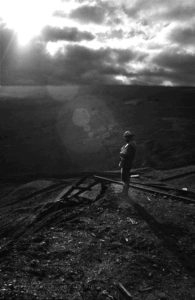
Why didn’t they foresee this tragedy? He told us that they had in fact, and they complained to the Coal Board numerous times.
“Why didn’t someone, anyone, move that blasted tip before it moved on its own?” one miner asked me! Why? Why? Oh, my God, why? There were so many “whys?” asked of me as I sat there, cameras in hand, dumbstruck for I had no answers. And soon this mood of helplessness began to overtake me and I had only one way to combat it—take pictures and more pictures and never stop until Life brought me back home.
At last I had to go to the cemetery, a place where mourners continued to visit hourly, to stand in front of their childrens’ graves. At first I went there without cameras and gently talked to the grieving parents. One woman, visiting her daughter’s grave said, without turning to me, “You’re the Yank cameraman. From the American paper.” I admitted to that. I told her I would like to take her photograph visiting the grave, and she said she comes morning and afternoons. I returned with my cameras and photographed her and her sister as they hovered over the flower-strewn mound of earth.
I spend a lot of time at the cemetery. Both to find the photographs that had meaning for my telling of the story of The Days After and also for dealing with my own grief which had begun to overtake me. Though I had lost nothing in the disaster, in some way I was exploiting it. The painful grieving that confronted me morning and night was taking its toll and I felt cleansed when I visited the gravesites.
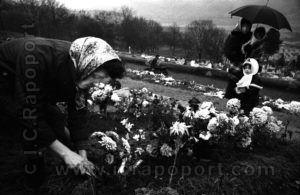
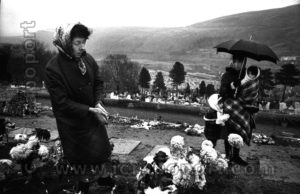
[x_blockquote type=”center”]This is Part One in a Series. Subscribe below to be notified of new posts. [/x_blockquote]

Leave a Reply